Grumman E-1 Tracer
| E-1 Tracer | |
|---|---|
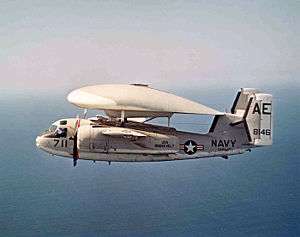 | |
| E-1B Tracer | |
| Role | Carrier AEW |
| Manufacturer | Grumman |
| First flight | 17 December 1956 |
| Introduction | 1958 |
| Retired | 1977 |
| Status | Retired |
| Primary user | United States Navy |
| Number built | 88 |
| Developed from | Grumman C-1 Trader |
The E-1 Tracer was the first purpose built airborne early warning aircraft used by the United States Navy. It was a derivative of the Grumman C-1 Trader and first entered service in 1958. It was replaced by the more modern E-2 Hawkeye in the early 1970s.
Design and development
The E-1 was designated WF under the 1922 United States Navy aircraft designation system; the designation earned it the nickname "Willy Fudd". Since the S-2 Tracker carrier-based antisubmarine aircraft from which the Tracer was derived known as S2F under the old system, that aircraft was nicknamed "Stoof"; the WF/E-1 with its distinctive radome gained the nickname "Stoof with a Roof."[1] The E-1 featured folding wings for compact storage aboard aircraft carriers. Unlike the S-2 and C-1 in which the wings folded upwards, the radome atop the fuselage necessitated the E-1 to fold its wings along the sides of the fuselage.[2]
Radar
The Tracer was fitted with the Hazeltine AN/APS-82 in its radome and fuselage. The radar featured an Airborne Moving Target Indicator (AMTI), which compares the video of one pulse time to the next in reflected radar energy to distinguish a flying aircraft from the clutter produced by wave action at the ocean's surface. The energy reflected from an aircraft changes position rapidly compared to the energy reflected from the surrounding sea. Separating a moving object from stationary background is accomplished by suitable hardware.
Operational history
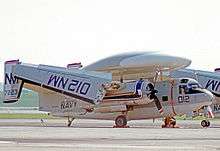
As one of the first carrier based early warning aircraft, the E-1 Tracer served from 1958 to 1977, although considered only an interim type, being replaced by the Grumman E-2 Hawkeye in the mid-1960s. During the early years of the Vietnam War, E-1s saw extensive service, providing combat air patrol (CAP) fighters with target vectors, and controlling Alpha strikes over North Vietnam. With a radius of 250–300 miles, the E-1B served as an early warning to strike aircraft, of enemy MiG's activity.[3]
By May 1973, most E-1Bs were retired, with only four VAW-121 Tracers based at NAS Norfolk, Virginia, still in service. These aircraft were soon retired during mid-summer 1977 following a final cruise on board the USS Franklin D. Roosevelt (CV-42) and were ferried to the Davis-Monthan storage facility. The E-1B Tracer was struck from the inventory by 1977.
Variants
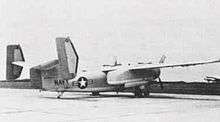
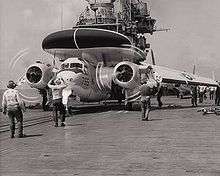
- XTF-1W
- aerodynamic prototype (BuNo 136792) without electronics, later rebuilt as a standard C-1A, retaining the twin tail.
- XWF-1
- The XTF-1W re-designated in the W-Warning category.
- WF-2
- Production Airborne Early Warning version of the TF-1 Trader, redesignated E-1B in 1962, 88 built.
- E-1B
- WF-2 redesignated in 1962.
Operators
Aircraft on Display
There are five E-1 Tracers preserved at museums throughout the United States:
- E-1B, BuNo 147212: Intrepid Sea, Air & Space Museum, New York City [4]
- E-1B, BuNo 147217: New England Air Museum, Windsor Locks, Connecticut [5]
- E-1B, BuNo 147225: On board the USS Yorktown (CV-10), Patriots Point, Mount Pleasant, South Carolina [6]
- E-1B, BuNo 147227: Pima Air & Space Museum, adjacent to Davis-Monthan AFB in Tucson, Arizona [7]
- E-1B, BuNo 148146: National Naval Aviation Museum, Naval Air Station Pensacola [8]
Another 11 E-1 Tracers are in storage at United Aeronautical, an aircraft surplus yard located just outside Davis–Monthan Air Force Base in Tucson, Arizona.[6] At least one of those aircraft (E-1B, BuNo 148922) was sold to a private collector in 2011 with the intent to restore to fly, although no updates on the project have been posted since 2012.[9][10]
Specifications
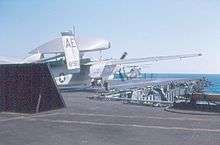
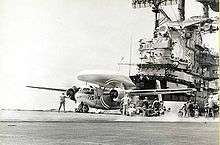
Data from Standard Aircraft Characteristics[11]
General characteristics
- Crew: 4, two pilots, two RADAR/Intercept Controllers
- Length: 45 ft 4 in (13.82 m)
- Wingspan: 72 ft 4 in (22.05 m)
- Height: 16 ft 10 in (5.13 m)
- Wing area: 506 sq ft (47.0 m²)
- Empty weight: 20,638 lb (9,381 kg)
- Loaded weight: 24,800 lb (11,273 kg)
- Max. takeoff weight: 26,600 lb (12,091 kg)
- Powerplant: 2 × Wright R-1820-82A Cyclone 9-cylinder radial piston engine, 1,525 hp (1,137 kW) (take-off power) each
Performance
- Maximum speed: 207 knots (238 mph, 383 km/h) at 4,000 ft (1,220 ft)
- Cruise speed: 142 knots (163 mph, 263 km/h)
- Range: 900 nmi (1,035 mi, 1,666 km)
- Endurance: 6.83 hrs (4.63 hrs on station at 150 nmi (278 km) at 5,000 ft (1,500 m)
- Service ceiling: 15,800 ft (4,800 m)
- Rate of climb: 1,120 ft/min (5.7 m/s) at sea level
See also
- Related development
- Aircraft of comparable role, configuration and era
References
Notes
- ↑ O'Rourke, G.G., CAPT USN. "Of Hosenoses, Stoofs, and Lefthanded Spads". United States Naval Institute Proceedings, July 1968.
- ↑ Jackson, David D. "Surviving Grumman S2F Tracker Information Repository." s2ftracker.com. Retrieved: 29 October 2011.
- ↑ Sullivan 1990, p. 7.
- ↑ http://www.warbirdregistry.org/trackerregistry/tracer-147212.html
- ↑ http://www.neam.org/index.php?option=com_content&view=article&id=897
- 1 2 http://www.s2ftracker.com/usatracers.htm
- ↑ http://www.pimaair.org/visit/aircraft-by-name/item/grumman-e-1b-tracer
- ↑ http://www.navalaviationmuseum.org/attractions/aircraft-exhibits/item/?item=e-1_tracer
- ↑ http://www.s2ftracker.com/unitedaerotracerphotos.htm
- ↑ http://www.s2ftracker.com/trackerupdates.htm
- ↑ "Standard Aircraft Characteristics:Navy Model E-1B Aircraft: NAVAIR 00-110AW1-1." Naval Air Systems Command, 1 July 1967.
Bibliography
- Sullivan, Jim. S2F Tracker in Action (Aircraft in Action No. 100). Carrollton: Texas: Squadron/Signal Publications, 1990. ISBN 978-0-89747-242-5.
- Winchester, Jim, ed. "Grumman S-2E/F/G/UP Tracker." Modern Military Aircraft (Aviation Factfile). Rochester, Kent, UK: Grange Books plc, 2004. ISBN 1-84013-640-5.
External links
| Wikimedia Commons has media related to Grumman E-1 Tracer. |
- Global Security.org page on WF-2/E-1 Tracer
- Airborne Moving Target Indicator (AMTI) explanation provided by Mercury Computer